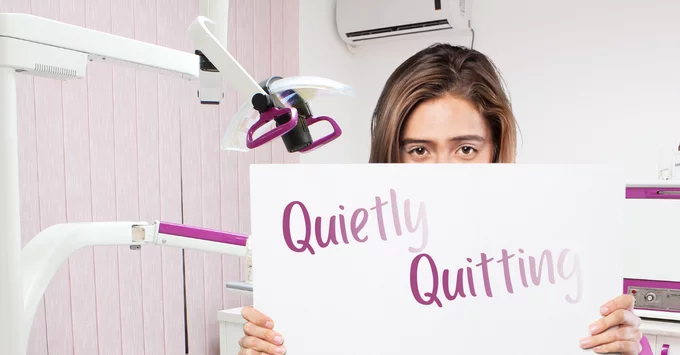By Erin Haley-Hitz, RDH, BSDH, MS, FADHA
2023-2024 ADHA President Elect
Quiet quitting a not a new phenomenon. Every generation has gone through a similar period at one time or another, but it has looked and felt different every time.
A look back reveals that each generation has experienced a similar pattern of work crisis followed by a reconceptualization. Stepping back to reconsider while staying on the job. We all eventually find that we must conform to be successful in our own lives. However, there are costs to the quietly quitting phenomenon. Sometimes the cost can be great for a profession. Quiet quitting is the messy start of a new generation embarking on the challenge of defining how their work fits into a well-lived life. This is an evolution that must happen.
Quiet quitting isn’t deliberate
Essentially, employees begin feeling underappreciated and undervalued, which leads to decreased productivity. As mentioned by best-selling author, employee engagement and culture speaker Joshua Evans, every organization wants high achievers. Still, employers must learn to cultivate them or run the risk of creating an environment that will see a reduction in productivity and workplace satisfaction. As it turns out, organizations that support their employees’ overall well-being see an increase in the number of high achievers within their organizations. Dentistry is also an industry that thrives on high performers. Let’s face it. Dentistry is a high-stress, high-impact profession with that impact showing on every smile that walks in and out of a dental practice. The stakes are high when working in the field of dentistry.
It’s the alternative to resigning
Dental hygienists have been working hard in an environment that has not always valued their input. Then the pandemic hit. We were shut down and sent home, and told we were not essential workers. For the sake of this article, I am not addressing the essentialism of dental hygiene but rather the general well-being of dental hygienists. As practices re-opened, many hygienists returned to the workplace only to find that nothing had really changed. This was compounded by the burnout we had already been experiencing, and led us to quietly step back while we completed our work as if we didn’t matter. This quiet quitting action means we began opting out. We did not completely disengage, but we returned to a less engaged state that had already been happening before the pandemic, back to where many of us were already feeling undervalued or unappreciated by employers and by patients.
Employees not quitting is costlier
Employers will quickly say that losing employees is difficult. Still, it may be more difficult having an employee NOT quit, and their unwillingness to go the extra mile often increases the burden of work on colleagues instead. While going above and beyond can come at a cost for employees, in a healthy work environment, this is counterbalanced by benefits such as increased social capital, well-being and career success. A quiet quitting trend suggests that this counterbalance has become unbalanced. This might sound familiar to some, but over the course of the last few years, hygienists have been experiencing heavier patient loads on their daily schedules with shortened treatment times and, for some, no additional compensation or benefits as a result. I don’t intend to convey that dental employers are not compassionate or thankful for hygienists’ work. But more work for less is counterintuitive to being rewarded for going the extra mile with additional benefits within the workplace.
The good news is that there are steps that can be taken to address these root causes of quiet quitting. This can include redefining core job tasks, listening to and investing in your employees, less hustle, and crafting meaningful work for employees. These are big tasks to undertake, but they can be achieved with diligent work.
The impact goes beyond
Quiet quitting has influenced professional associations. Membership and service to the profession are impacted when a profession is in crisis and many factors play a role in this. Part of this is a spin-off from a lack of appreciation within the workplace, financial uncertainties, and ultimately, the changing needs of the membership. These all create a disconnect resulting in a struggle to reconnect with potential members. Associations are under increasing competition with free resources, and must continually prove why a paid membership is worth the investment. This article is not about building membership; ultimately, we must create a missable unique value. What would be missable to you?
Proactivity protects our profession
This lack of involvement, in general, is leading to a behavior of apathy. This limits the advancement of our profession and could lead to our scope of practice being picked apart piece by piece without input from dental hygienists. The pandemic was not the cause; it was a catalyst that came about and allowed dental hygienists to reevaluate where they want to work and how they want to do their jobs. Are we quietly quitting our profession? We have fallen into a reactionary pattern rather than proactive action. By being reactive, we are simply waiting for someone else to do something or allowing someone else to pick apart our scope of practice. Waiting until the threat comes does not serve us well in the end. Being proactive serves our profession better.
The Gen Z generation has entered the workplace and is estimated to make up over 27% of the workforce in just two years. We must help our Gen Z generation learn and understand how to protect their profession. The best way to do this is for the rest of us to join our professional association and invite them to join. We must provide a stable financial infrastructure for advocacy for our future and theirs. Membership dues help organizations develop tools to assist the leaders who are working to protect and advance our profession. We need every dental hygienist to join us by supporting the initiatives to achieve our highest goal: to advance our profession and protect our scope of practice.
So, let’s stop stepping back and quietly quitting, and instead step forward to proactively ensure our advocatory future.
_______________________________________
References:
1. Is quiet quitting real? Harter, Jim. Gallup 9/6/22, accessed on 4/4/23 https://www.gallup.com/workplace/398306/quiet-quitting-real.aspx?version=print
2. The Year in Quiet Quitting, accessed 4/4/23 The New Yorker , Newport, Cal, 12,29,22 https://www.newyorker.com/culture/2022-in-review/the-year-in-quiet-quitting#:~:text=%E2%80%9CI%20recently%20learned%20about%20this,has%20to%20be%20your%20life.
3. What is quiet quitting- and is it a real trend? Daugherty, Greg. Investopedia, 2/25/23, accessed 4/4/23 https://www.investopedia.com/what-is-quiet-quitting-6743910
4. When Quiet quitting is worse than the real thing, Koltz, Anthony &Bolino, Mark, Harvard Business Review 9/15/22, accessed 4/4/23 https://hbr.org/2022/09/when-quiet-quitting-is-worse-than-the-real-thing
5. The economics behind, ‘quiet quitting’-and what we should call it instead , Rosalsky, Greg & Selyukh, Alina, NPR, 9/13/22, accessed on 4/4/23 https://hbr.org/2022/09/when-quiet-quitting-is-worse-than-the-real-thing
6. Declining Membership in Professional Organizations and What You Can Do About It, Sidecar.org 4/26/21 https://sidecarglobal.com/member-engagement/declining-membership-in-professional-organizations-and-what-you-can-do-about-it/, accessed on 4/15/23
7. You Checked out at Work. Here’s how to check back in. Goredema, Octavia. Harvard Business Review, 4/4/23 https://hbr.org/2023/04/you-checked-out-at-work-heres-how-to-check-back-in, accessed on 4/15/23


